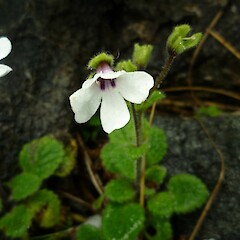Ourisia remotifolia
Common name
mountain foxglove
Synonyms
None (described in 1984)
Family
Plantaginaceae
Flora category
Vascular – Native
Endemic taxon
Yes
Endemic genus
No
Endemic family
No
Structural class
Herbs - Dicotyledons other than Composites
NVS code
The National Vegetation Survey (NVS) Databank is a physical archive and electronic databank containing records of over 94,000 vegetation survey plots - including data from over 19,000 permanent plots. NVS maintains a standard set of species code abbreviations that correspond to standard scientific plant names from the Ngä Tipu o Aotearoa - New Zealand Plants database.
OURREM
Chromosome number
2n = 48
Current conservation status
The conservation status of all known New Zealand vascular plant taxa at the rank of species and below were reassessed in 2017 using the New Zealand Threat Classification System (NZTCS) – more information about this can be found on the NZTCS website. This report includes a statistical summary and brief notes on changes since 2012 and replaces all previous NZTCS lists for vascular plants.
Please note, threat classifications are often suggested by authors when publications fall between NZTCS assessment periods – an interim threat classification status has not been assessed by the NZTCS panel.
- Conservation status of New Zealand indigenous vascular plants, 2017 . 2018. Peter J. de Lange, Jeremy R. Rolfe, John W. Barkla, Shannel P. Courtney, Paul D. Champion, Leon R. Perrie, Sarah M. Beadel, Kerry A. Ford, Ilse Breitwieser, Ines Schönberger, Rowan Hindmarsh-Walls, Peter B. Heenan and Kate Ladley. Department of Conservation. Source: NZTCS and licensed by DOC for reuse under the Creative Commons Attribution 4.0 International licence.
2017 | At Risk – Naturally Uncommon | Qualifiers: RR, Sp
Previous conservation statuses
2012 | At Risk – Naturally Uncommon | Qualifiers: RR, Sp
2009 | At Risk – Naturally Uncommon
2004 | Range Restricted
Distribution
Endemic. South Island, Mt Cook National Park, Westland National Park and Fiordland National Park
Habitat
Alpine (1000-2200 m a.s.l.). Locally common in southerly or southwesterly facing talus slopes, bluffs, sheltered snow hollows; in rock crevices or on bare rock. Rarely in damp seepages within alpine herbfield.
Detailed description
Perennial herb 39-102 mm tall with ascending to erect inflorescences and repent leaves; stems 2.0-3.5 mm diameter; internodes 2.1-13.3 mm long, glabrous or pilose, hairs long, eglandular. leaves opposite, sometimes tightly tufted near apex of stem (never rosulate); petiole 2.6-18.5 x 0.9-4.8 mm, pilose, glandular hairs isolated, long to very long, glandular hairs densely distributed toward margin, long to very long; lamina 6.9-24.0 x 6.9-20.3 mm, broadly to very broadly ovate, apex rounded, base cuneate, sometimes subtruncate, margin crenate, teeth mostly with hydathodes, upper surface pilose or villous, hairs mostly eglandular, long to very long, undersides glabrous or pilose, vestiture of mixed glandular and eglandular hairs, especially along prominent veins, often punctate. Inflorescence racemose, 42-108 mm long, bracteate, 1-6-flowered; peduncle 1.1-1.7 mm diameter, densely glandular pilose. Floral bracts 9.5-17.6 x 5.3-9.1 mm, reducing in size toward inflorescence apex, sessile, parallel to peduncle or slightly spreading, narrowly obovate, oblanceolate, margin crenate bearing 3-5 teeth in distal portion, glabrous or glandular/eglandular pilose. Flowers 12.2-16.7 x 11.0-14.7 mm; pedicel 6.7-21.0 mm long, densely glandular pilose. Calyx 5.7-7.7 x 4.3-8.0 mm, irregular, externally glandular/eglandular pilose or villous, internally glabrescent, margin snot ciliate; anterior calyx lobes 5.0-6.8 x 1.5-2.4 mm, posterior calyx lobes 1.2-4.2 x 1.2-2.2 mm, 3 posterior calyx lobes divided 1/4-1/2 of calyx length, 2 anterior lobes divided to near base, lanceolate or narrowly elliptic, apex rounded or acute, mucronate or slightly emarginate, upper surface prominently 1-3-veined. Corolla 12.5-17.7 x 13.0-20.4 mm when flattened, bilabiate, tubular-funnelform, white, glabrous externally; tube 4.6-8.1 x 3.3-5.2 mm at apex, 2.5-3.7 mm wide at base, not constricted near base, curved or slightly curved, purple inside with 3 lings of hairs; anterior corolla lobes 5.6-9.2 x 4.3-6.9 mm, 2.0-3.7 mm wide at base. posterior corolla lobes 3.6-6.4 x 3.0-5.0 mm at widest point, 1.6-2.7 mm wide at base, spreading, obcordate or slightly obovate, apically emarginate. Stamens 4, didynamous, glabrous bases not expanded; 2 long stamens 4.2-7.0 mm long, reaching tube or exserted; two short stamens 3.2-5.8 mm long, included. Style 3.0-4.9 mm long, bent near base, exserted; stigma 0.3-1.0 mm diameter, emarginate; ovary 2.2-3.1 x 1.4-2.0 mm. glabrous. Capsules 3.9-6.5 x 3.3-6.2 mm, glabrous, with loculicidal dehiscence; fruiting pedicels 20.0-27.0 mm long. Seeds 0.7-1.1 x 0.3-0.6 mm.
Similar taxa
Closest to O. sessiliflora Hook.f. from which it differs by the lax, semi-erect rather than erect habit, soft-textured leaves on long petioles which are widely spaced, rather than close set, tufted or in rosettes; and by the posterior calyx lobes divided 1/4-1/2 the length of the calyx rather than with all calyx lobes divided to the calyx base.
Flowering
December - January
Flower colours
Violet/Purple, White
Fruiting
January - April
Propagation technique
Difficult - should not be removed from the wild
Threats
Not Threatened. Listed because it is considered to be a localised endemic.
Etymology
ourisia: After Ouris, governor of the Falkland Islands
remotifolia: Remote foliage (referring to the leaves’ distance from one another)
Where To Buy
Not commercially available.
Attribution
Description based on Meudt (2006).
References and further reading
Meudt, H.M. 2006: Monograph of Ourisia (Plantaginaceae), Systematic Botany Monographs 77. 188pp







